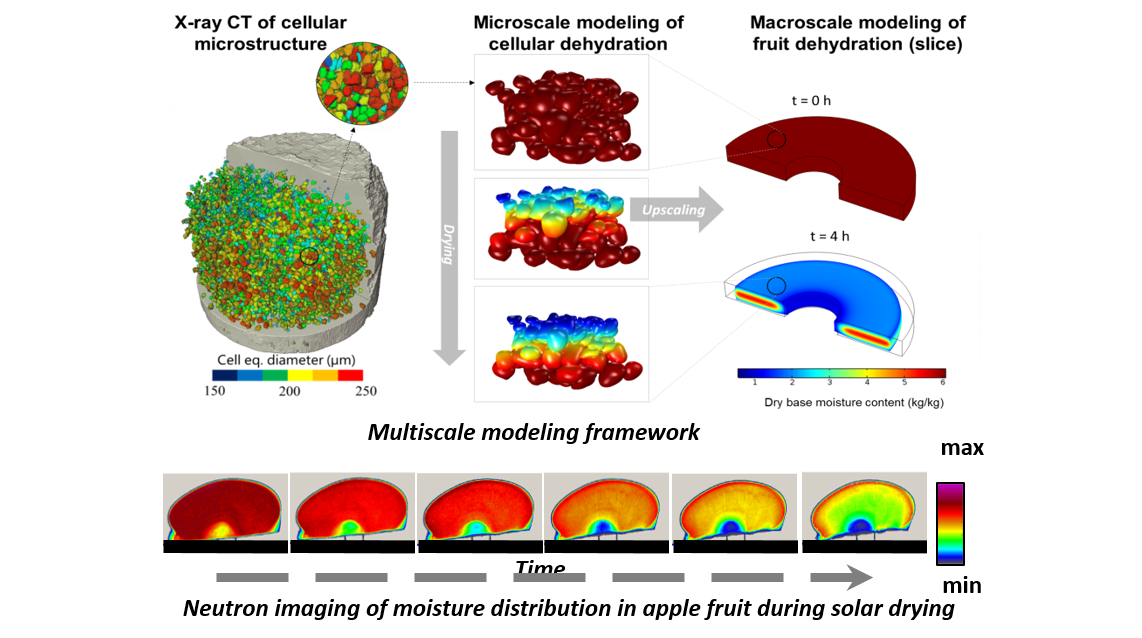Solar drying of soft cellular materials: a multiscale approach

Type. SNSF project
Funding. This PhD project is funded by the Swiss National Science Foundation (SNSF).
Duration. 3 years (2015-2018)
Collaborations. This project is a collaboration between the Chair of Building Physics (Dr. Defraeye, Prof. Carmeliet) at ETH Zurich and MeBioS (Prof. Nicolai) of KU Leuven.
Contact. Thijs Defraeye (principal investigator).
Staff. Kevin Prawiranto (PhD student).
Project background. SNF P3 database
Solar drying has become a very attractive way of reducing the process energy required for drying of foods, wastewater sludge or wood. This convective drying process is particularly difficult to control due to fluctuations in incident radiation from the day-night cycle and in the presence of clouds. Additional complexity comes from the use of auxiliary heating or airflow and thermal energy storage systems to dampen these fluctuations, and the associated rehydration of the material. During dehydration, the material also undergoes large changes in properties and microstructure versus moisture content.
The primary objective of this project is to get insights in the underlying physics of solar drying of soft cellular materials, such as fruits, by approaching this convective drying process from a multiscale perspective, from cellular scale to dryer scale. To this end, we relate the heat and mass transport and deformation processes within the fruit and the exchange at the air-fruit interface to the environmental and operational conditions, and to the changes in tissue microstructure. We aim to unveil how fruits dry with respect to their location and loading density in the dryer and what the efficiency is of selected technologies to dampen fluctuations in solar radiation.
Publications
- Prawiranto K., Defraeye T., Derome D., Bühlmann A., Hartmann S., Verboven P., Nicolai B., Carmeliet J. (2019). Impact of drying methods on the changes of fruit microstructure unveiled by X-ray micro-computed tomography, RSC Advances 9, 10606-10624. DOI and postprint
- Defraeye T., Radu A. (2018), Insights in convective drying of fruit by coupled modeling of fruit drying, deformation, quality evolution and convective exchange with the airflow, Applied Thermal Engineering 129, 1026-1038. DOI and postprint
- Prawiranto K., Defraeye T., Derome D., Verboven P., Nicolai B., Carmeliet J. (2018), New insights into the apple fruit dehydration process at the cellular scale by 3D continuum modelling, Journal of Food Engineering 239, 52-63. DOI and postprint
- Defraeye T. (2017), Impact of size and shape of fresh-cut fruit on the drying time and fruit quality, Journal of Food Engineering 210, 35-41. DOI and postprint
- Defraeye T., Verboven P. (2017), Moisture barriers to control drying of fresh-cut fruit: quantifying their impact by modeling, Food and Bioproducts Processing 101, 205–213. DOI and postprint
- Defraeye T. (2017), When to stop drying fruit: Insights from hygrothermal modelling, Applied Thermal Engineering 110, 1128–1136. DOI and postprint
- Defraeye T., Verboven P. (2017), Convective drying of fruit: Role and impact of moisture transport properties in modelling, Journal of Food Engineering 193, 95-107. DOI and postprint
- Defraeye T. (2016), Towards more efficient intermittent drying of fruit: insights from combined hygrothermal-quality modelling, Innovative Food Science and Emerging Technologies 38, 262-271. DOI and postprint
- Defraeye T., Nicolai B., Mannes D., Aregawi W., Verboven P., Derome D. (2016), Probing inside fruit slices during convective drying by quantitative neutron imaging, Journal of Food Engineering 178, 198-202. DOI and postprint
Funding Agency:
Staff:
PhD Student
Kevin Prawiranto
University:
